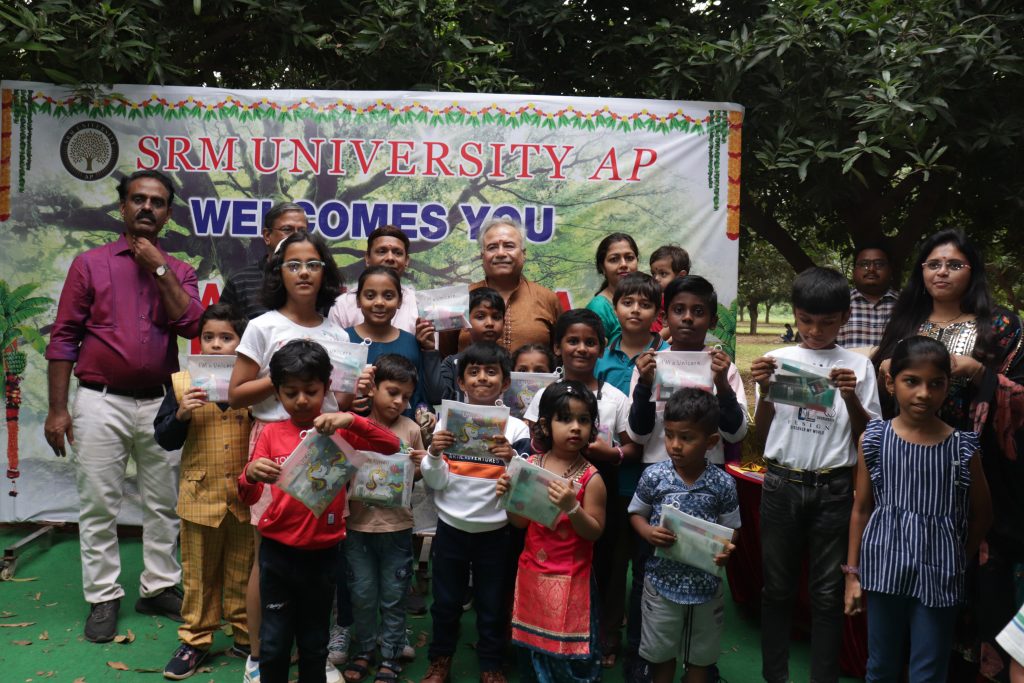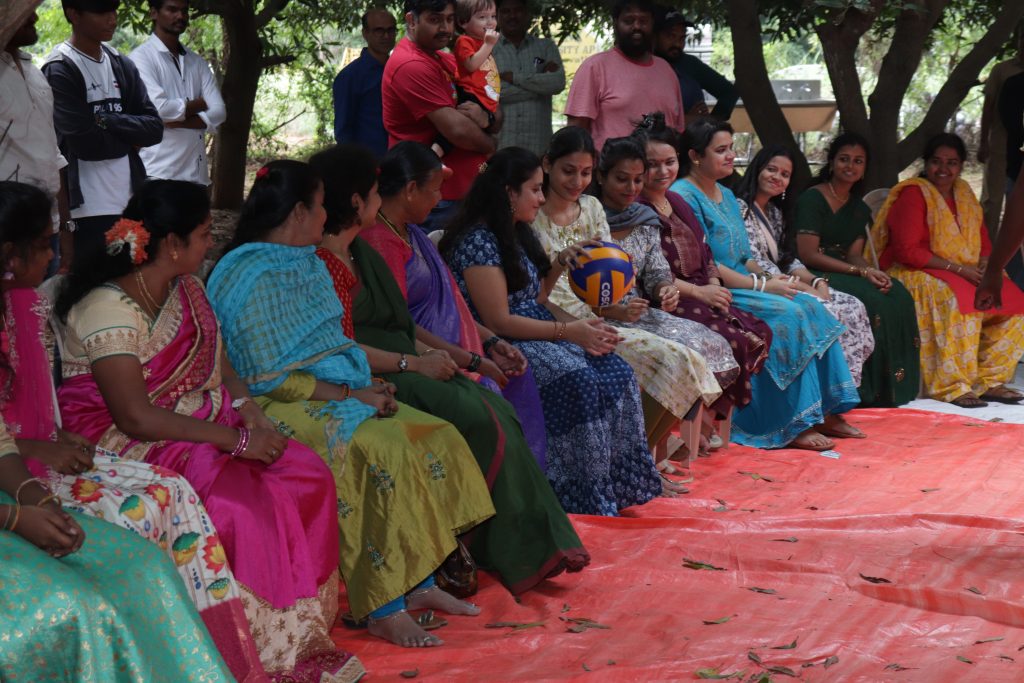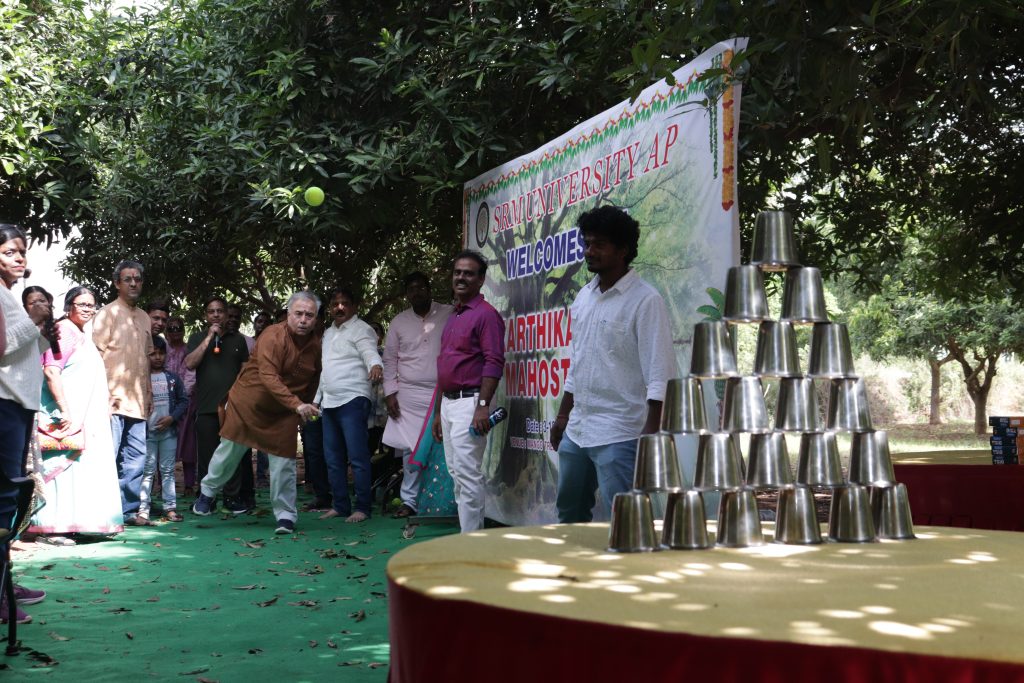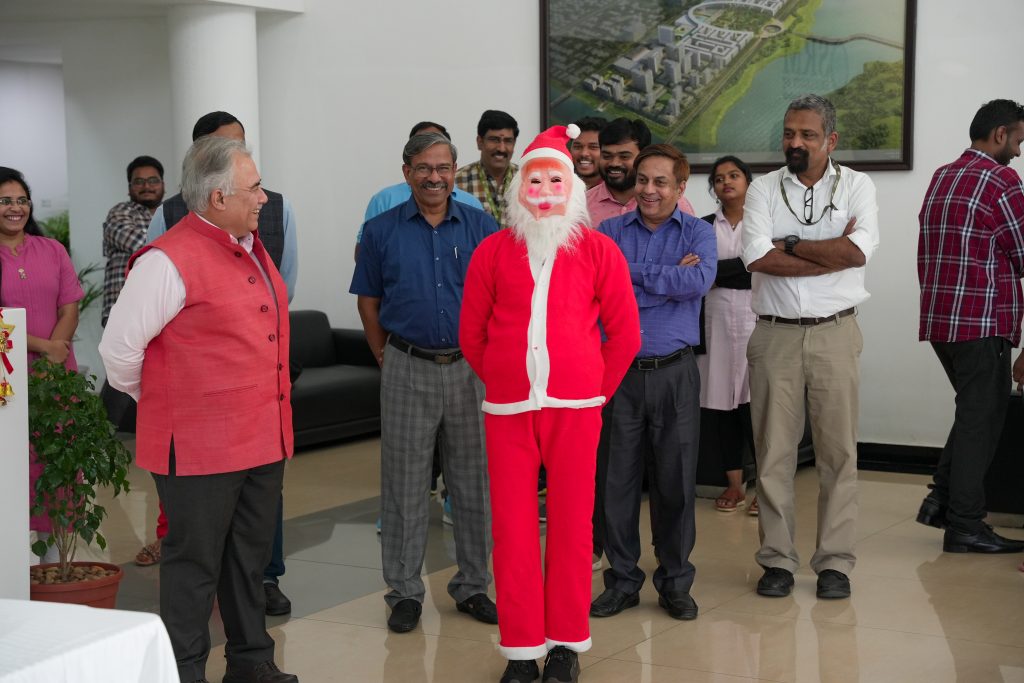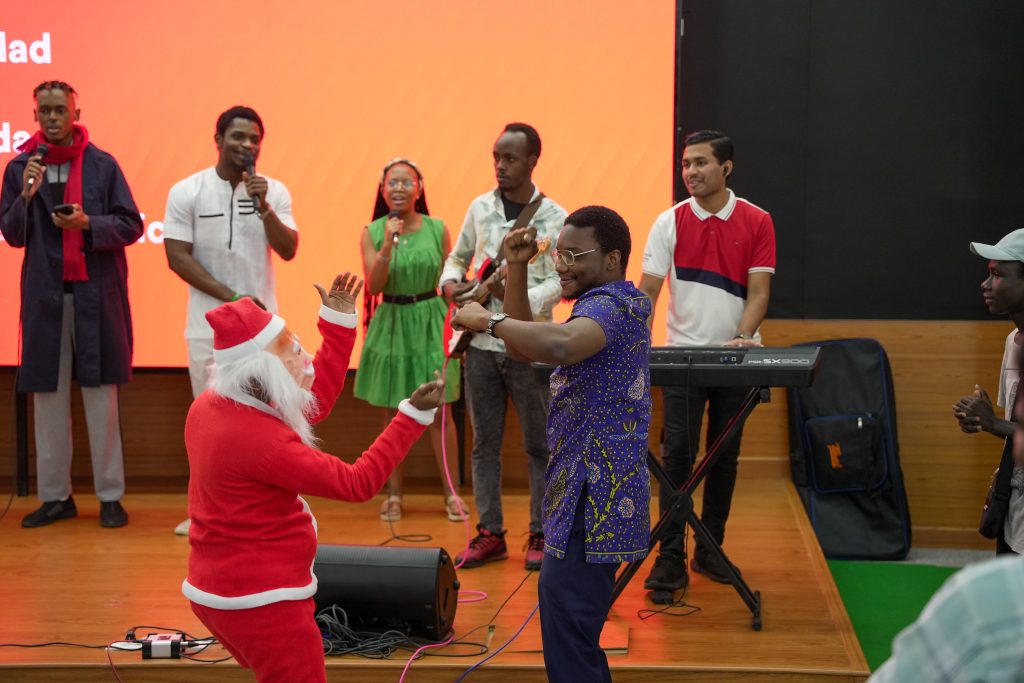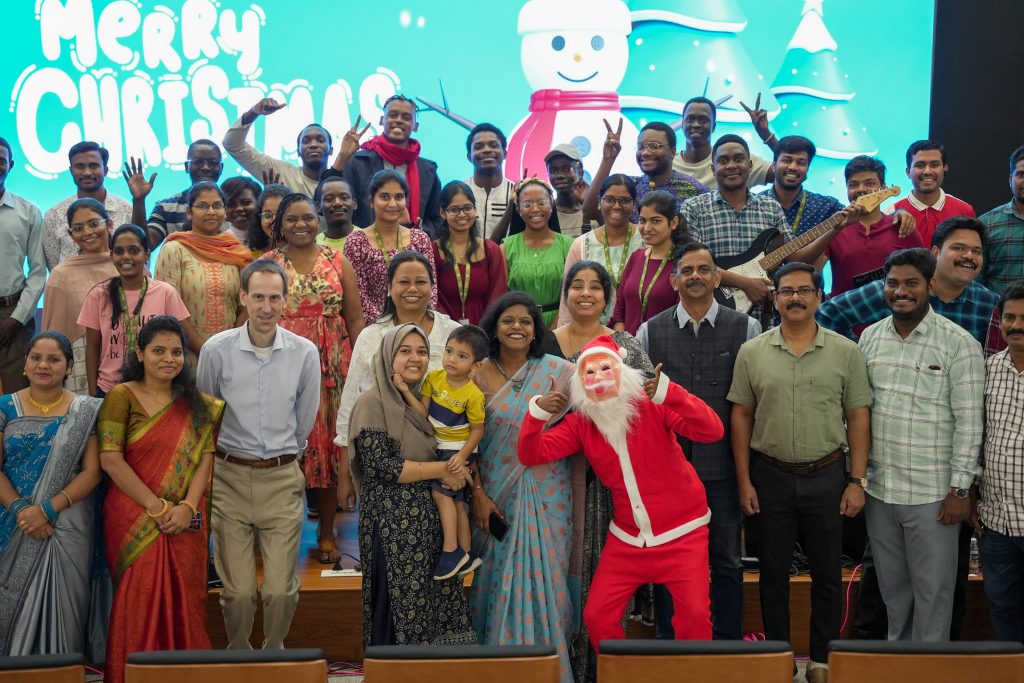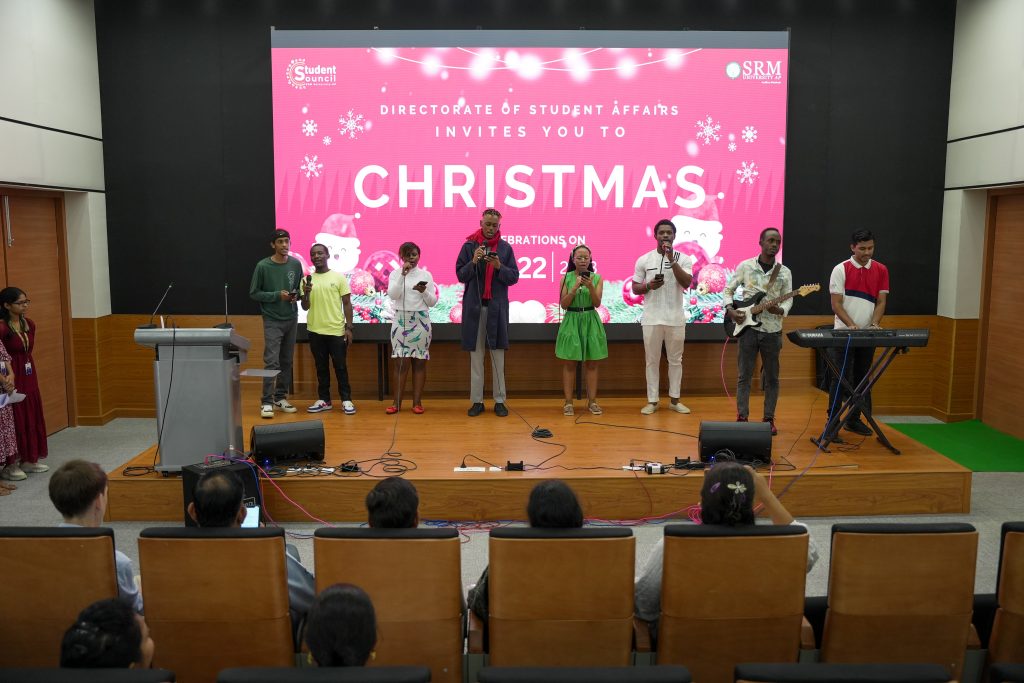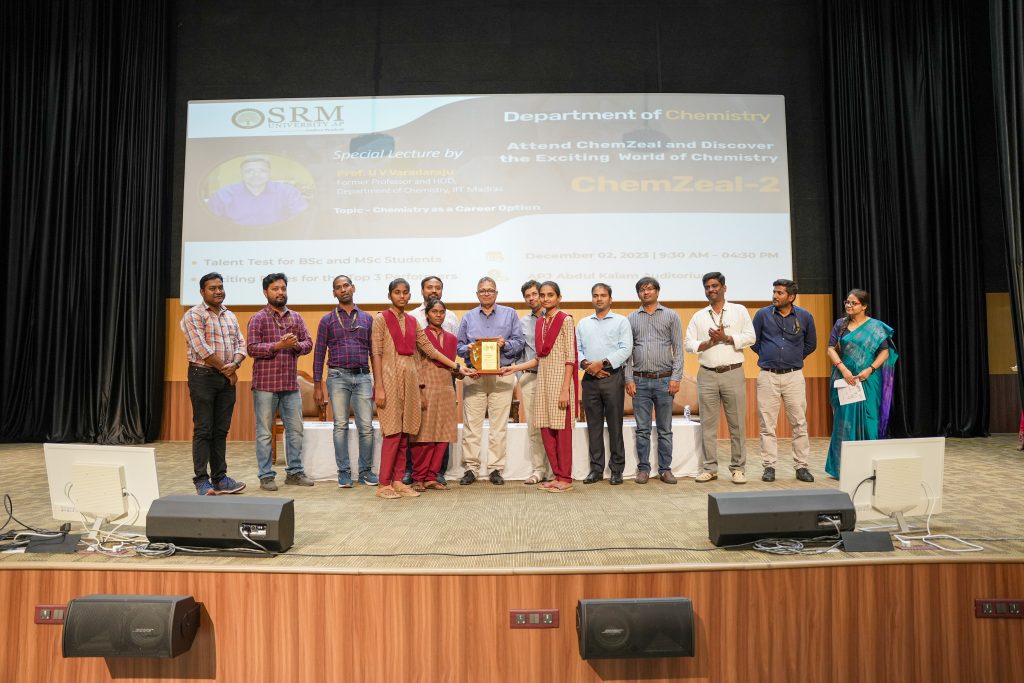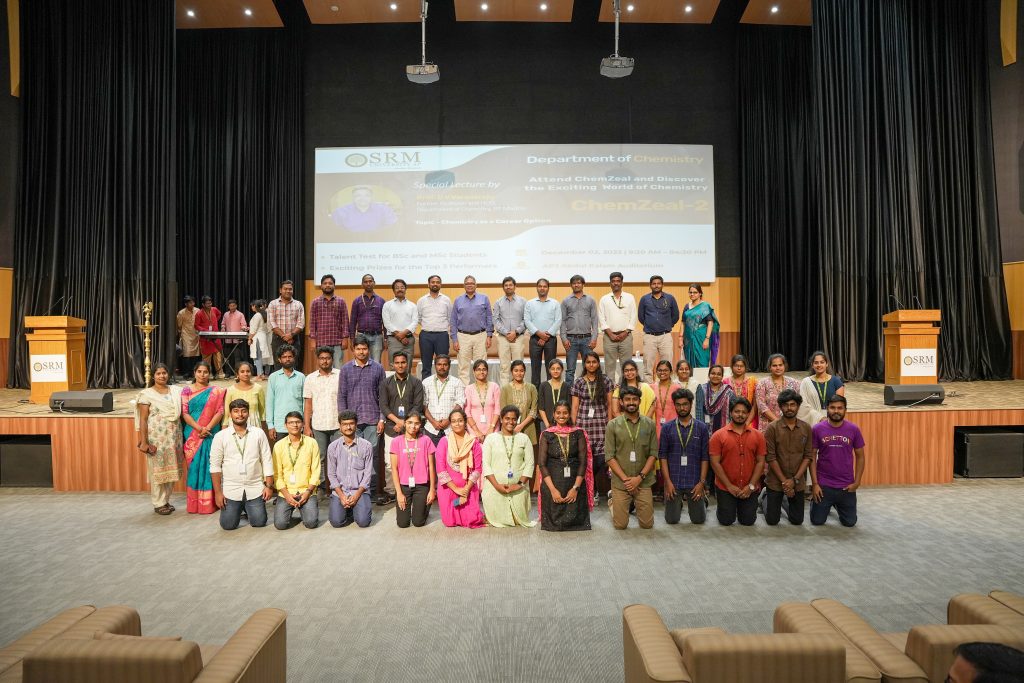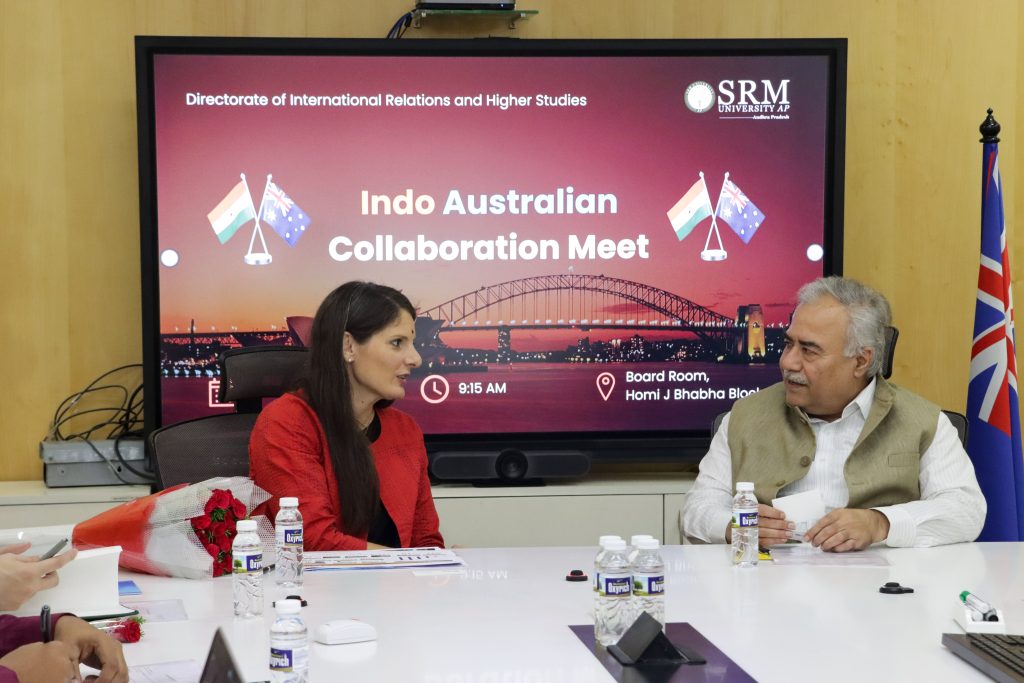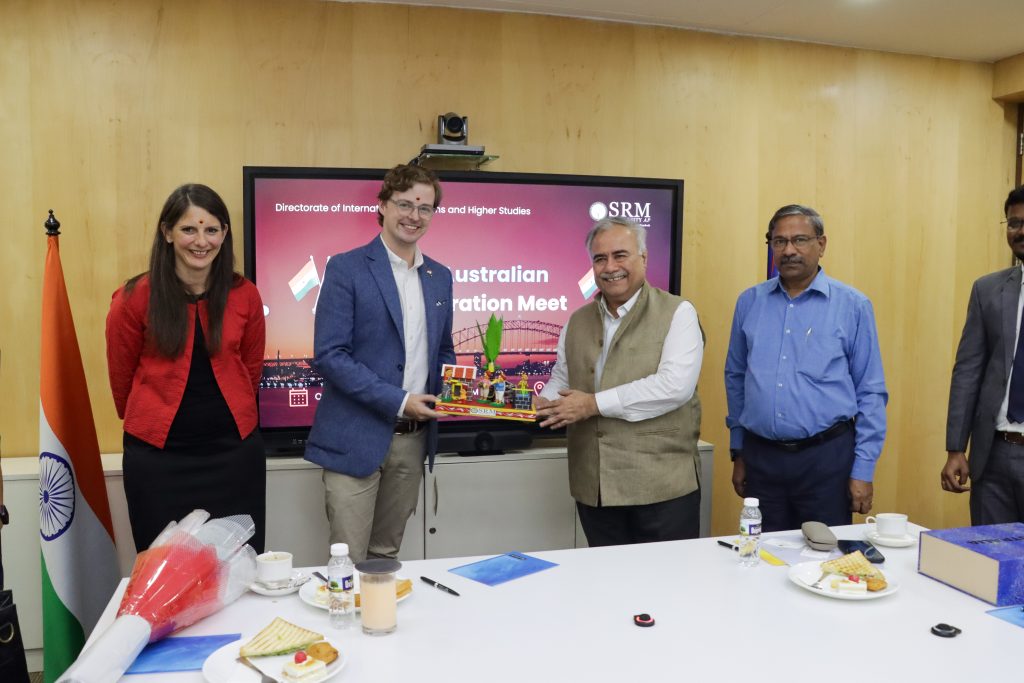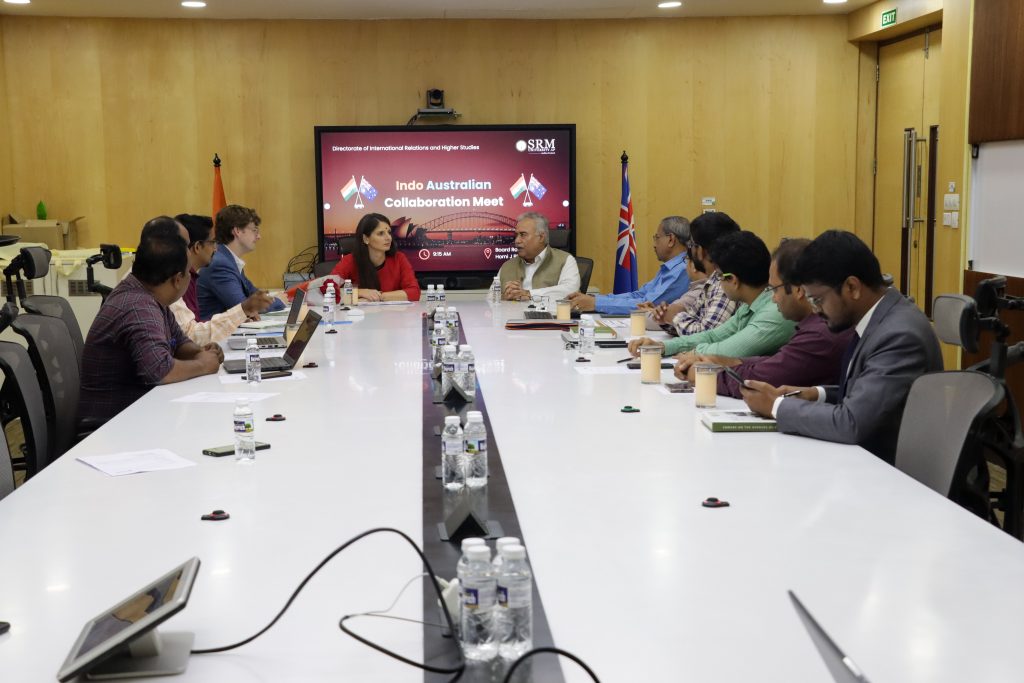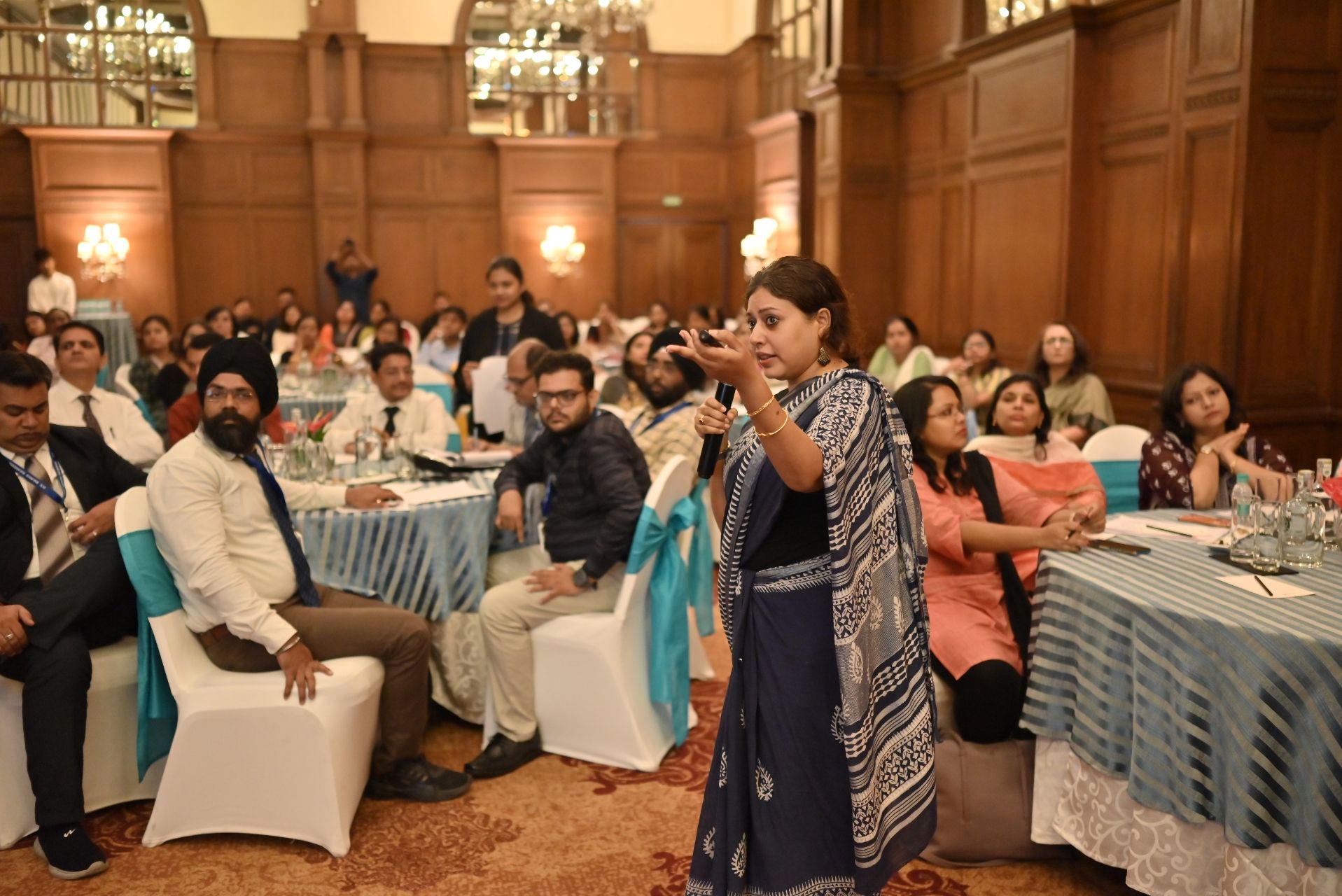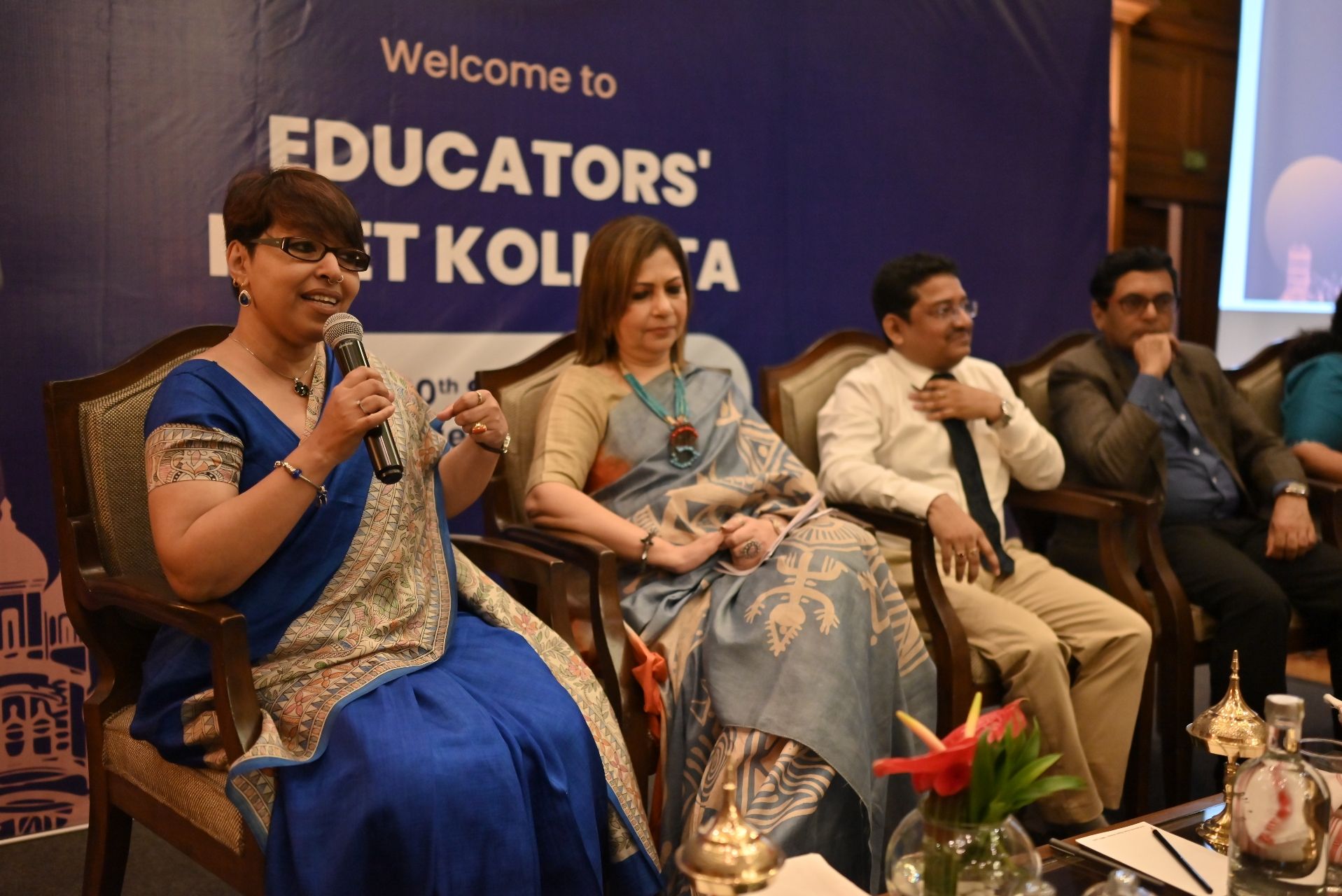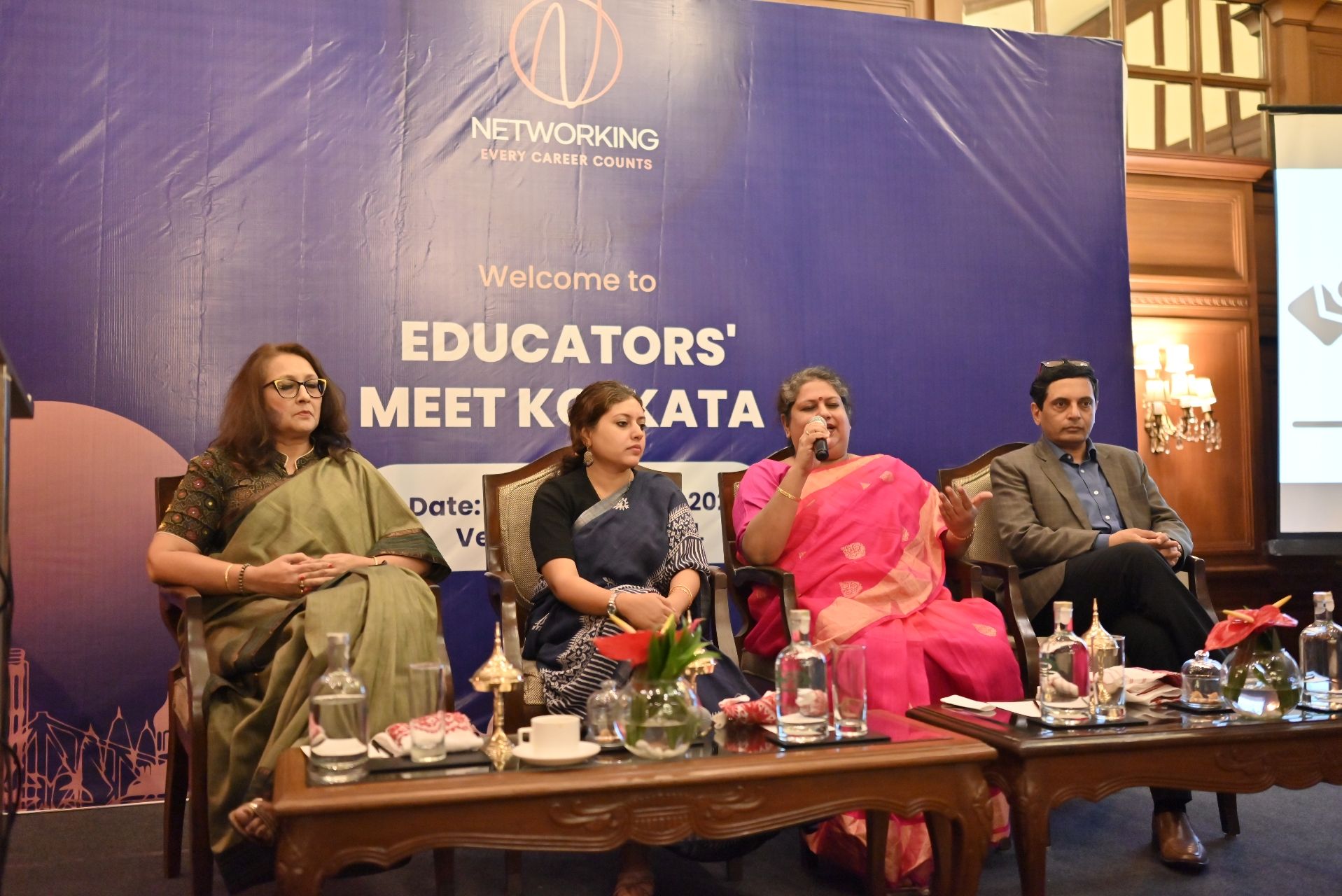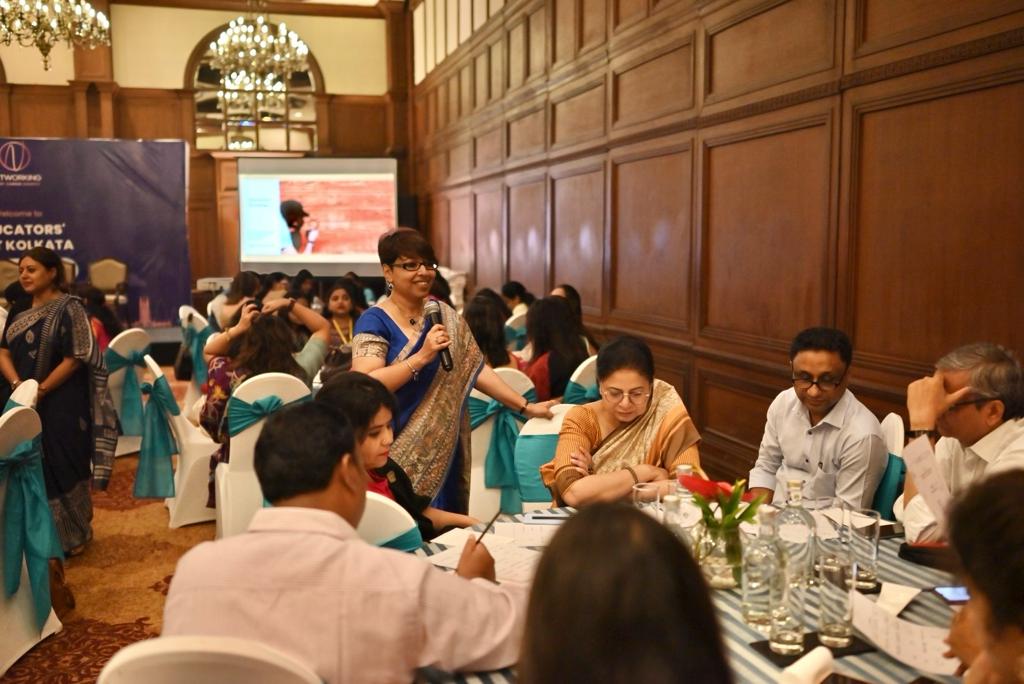Harvard Alumnus Joins SRM AP as Director – Entrepreneurship
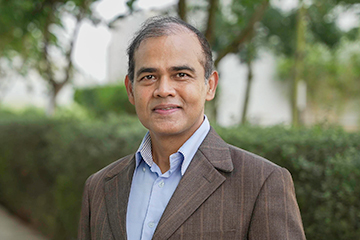
SRM University-AP has recently appointed Mr Sidharth Shankar Tripathy as its new Director of Entrepreneurship & Innovation and Professor of Practice in Entrepreneurship. This appointment is a significant milestone in the varsity’s effort to enhance the entrepreneurial fervour on campus, especially since it’s declaration of the year 2023 as The Year of Entrepreneurship.
Mr Sidharth Shankar Tripathy, an alumnus of Harvard University with a Post Graduate Diploma in Management from S P Jain Institute of Management & Research is a seasoned educator and entrepreneur, who has launched and led several global ventures successfully. As an accomplished entrepreneur, Mr Sidharth Tripathy has founded numerous successful ventures. Some of his notable achievements include establishing Brandgain, Asia’s first Sales & Marketing Process Outsourcing company, and Newzworm, the world’s first global news source for pre-adolescent and adolescent children. His enterprise, Skillizen Learning, provides life skills training across 72 countries. Additionally, he is also the co-founder of “iSEED-The Indian School of Entrepreneurship” and “Life Skills University, Singapore”.
Dr P Sathyanarayanan, Pro-Chancellor of the varsity, welcomed Mr Shankar Tripathy, stating that, “he is an invaluable asset to the university.” He said, “Under his expert guidance, the university will transform its entrepreneurial landscape to achieve institutional excellence.” Vice Chancellor, Prof. Manoj K Arora, also welcomed Mr Tripathy aboard. Prof. Arora expressed his appreciation of Mr Shankar Tripathy’s expertise and leadership that will guide the budding entrepreneurs of the varsity to scale new heights on global frontiers.
In response, Mr Shankar Tripathy expressed his excitement in joining SRM University-AP and stated that “the adrenalin rush of joining the varsity is quite akin to starting his first entrepreneurial venture 20 years back”. He also mentioned that he is thrilled to start this journey to make SRM University-AP, India’s Stanford.
The Entrepreneurship & Innovation Directorate at SRM University-AP is a burgeoning department with over 30 startups under incubation, women-led startups, national and international collaborators like Berkeley University of California, Stanford SEED, MHRD, Start-up India, MSME, and APSSDC to name a few. The varsity believes that the Directorate of Entrepreneurship and Innovation will further flourish with Mr Sidharth Shankar Tripathy at its helm.
- Published in News
Karthik Vana Mahotsava: A Green Celebration of Nature’s Bounty
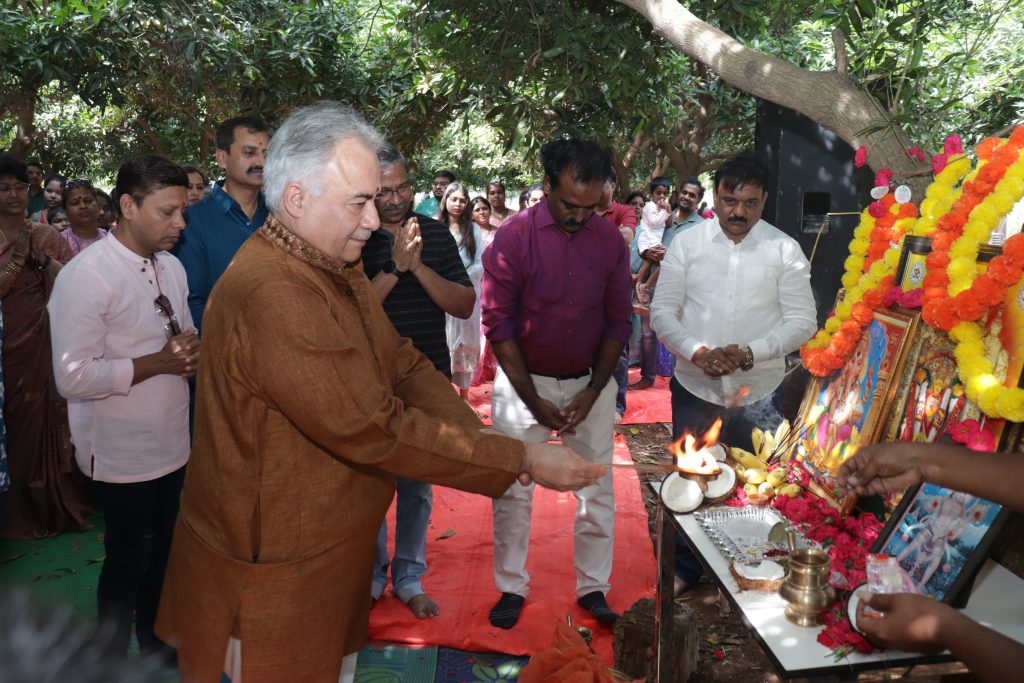
In the Karthik month of the Hindu calendar, a vibrant and eco-friendly celebration, Karthika Vana Mahotsavam took centre stage at SRM University-AP. The varsity honoured the tradition and fostered environmental consciousness with its Vanamahotsavam. This annual event has become a significant tradition in the varsity and draws faculty and staff and their family members from different communities together to celebrate the beauty of the earth and promote sustainable living.
The celebration that took place in the Mango Gardens, near Sri City in Nidamaru saw the participation of members of the leadership including Vice Chancellor, Prof. Manoj K Arora; Registrar, Dr R Premkumar, Directors and former members of the leadership. The Vana Mahotsava intended to honour both nature and celebrate the bond between humans and nature was organised by the Directorate of Human Resource Management.
The event also saw children and families bonding over games and other exciting activities organised by the Directorate. Vanamahotsavam was a holistic way of fostering a sense of responsibility for future generations and served as a reminder that small, concerted efforts can contribute significantly to the global movement for a greener and more sustainable planet
- Published in News, University Event
Celebrating Christmas on Campus: A Joyous University Tradition
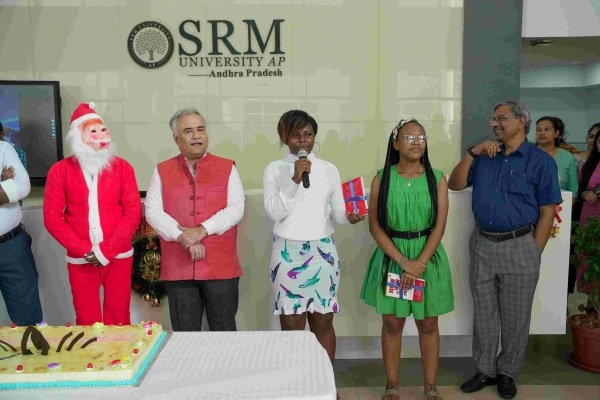
The spirit of Christmas echoed through the halls of our campus this year as students, faculty, and staff came together to celebrate the festive season. The Christmas celebration organised by the Directorate of Student Affairs was a grand affair, with enthusiastic participation from key figures, including the Vice-Chancellor, Registrar, Deans of all schools, and dedicated faculty and staff.
The event saw an inclusive participation of international students, adding a global touch to the festivities. The diverse cultural backgrounds of the international students enriched the celebration, reflecting the unity in diversity that defines the academic community at SRM University-AP.
One of the highlights of the Christmas celebration was the active involvement of the university leadership. The Vice-Chancellor, with a radiant smile, inaugurated the event, setting a joyous tone for the entire gathering. The heart of the celebration was the involvement of both local and international students. The student affairs directorate organised a series of entertaining games and activities that brought everyone together. International students, showcasing their unique talents, not only participated actively but also emerged victorious in several competitions, winning well-deserved prizes.
- Published in News, Students Affairs Events
A Research On Examining Stress Among Adolescents
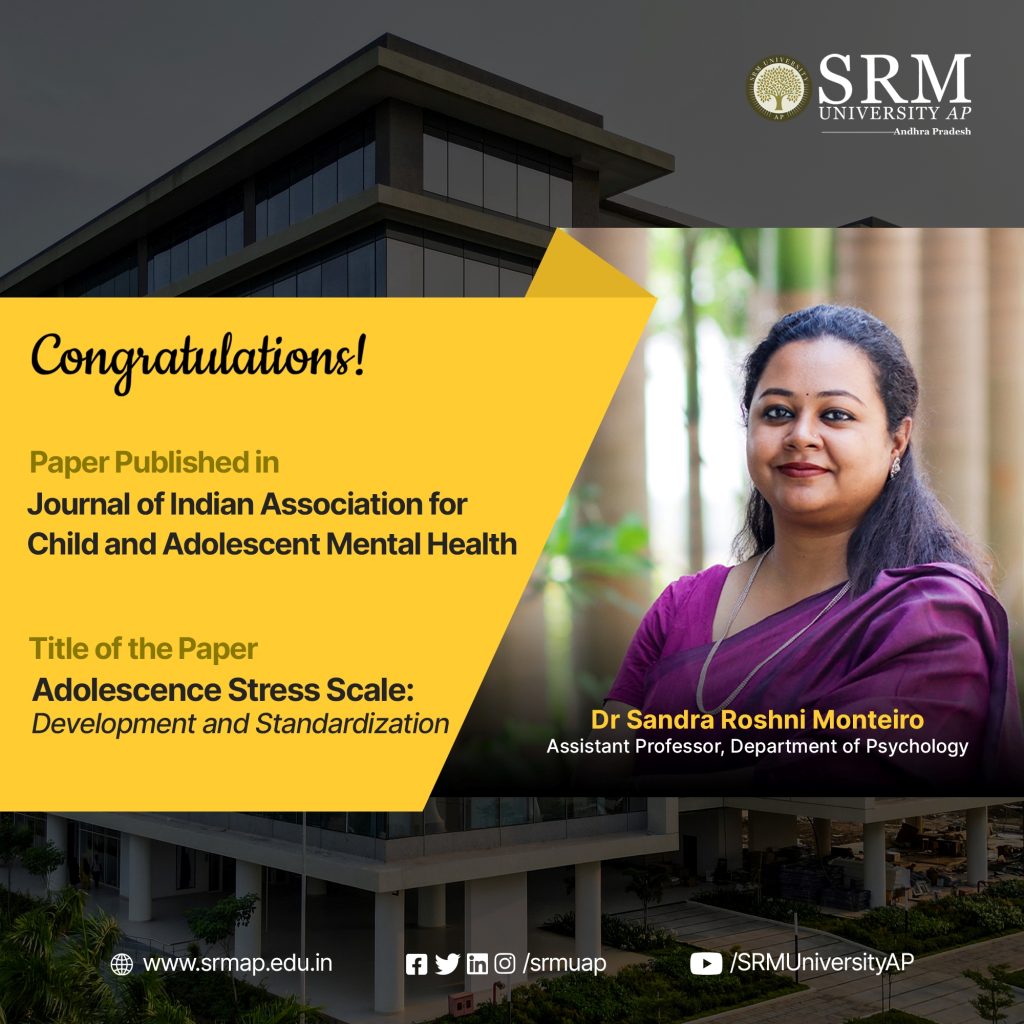
The research paper titled “The Adolescence Stress Scale: Development and Standardization” is a significant contribution to the field of psychology. The paper by Dr Sandra Roshni Monteiro, Assistant Professor at the Department of Psychology in SRM University-AP featured in The Journal of Indian Association for Child and Adolescent Mental Health and provides a detailed account of the development and standardisation of the scale, highlighting its importance and relevance. Dr Monteiro has developed a comprehensive stress scale that aims to evaluate the psychometric issues faced by school-going adolescents.
Here’s a brief extract of the paper.
Abstract
Background/Aim
The objective of the paper was to develop a comprehensive “Adolescence Stress Scale” and to examine different psychometric issues in the development, initial validation, and standardization of this scale.
Method
Exploratory factor analysis was conducted on the data procured from a sample of 634 (11–18 years) school-going adolescents in India.
Results
An exploratory analysis provided a 10-factor structure, namely, major loss-induced stress, enforcement or conflict-induced stress, phobic stress, interpersonal conflict-induced stress, punishment-induced stress, illness and injury-induced stress, performance stress, imposition-induced stress, insecurity-induced stress, and unhealthy environment-induced stress. The 10 oblique factor solutions are found to be interrelated and interdependent with good indices of internal consistency, and content validity.
Conclusions
This scale development is a novel and powerful measure that taps onto various aspects of stress experienced by school-going adolescents. The scale can facilitate researchers, clinicians, and teachers to identify and quantify the significant sources of stress in adolescents in school, or clinic settings.
- Published in Departmental News, News, Psychology News, Research News
ChemZeal 2: An Outreach Initiative by the Dept. of Chemistry
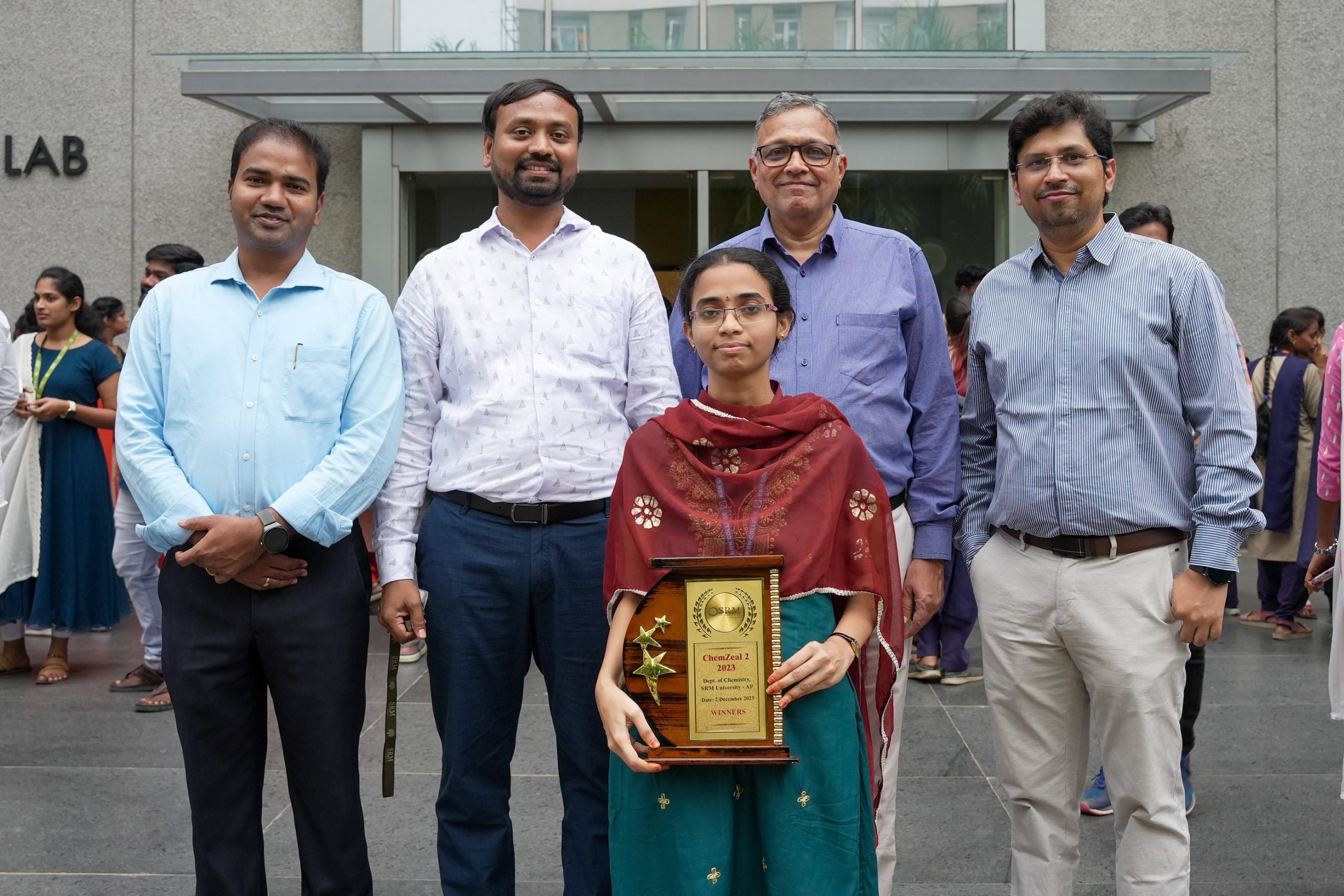
The Department of Chemistry at SRM University-AP organised an academic colloquium called ChemZeal 2 on December 02, 2023. The event aimed to promote the Department and its research among undergraduate and graduate students from various colleges. It also provided a platform for students to interact with chemistry enthusiasts and learn about the latest advancements and research in the field.
ChemZeal 2 featured a lecture by academic stalwart, Prof. U V Varadaraju on Solid-State Materials in Chemistry from the Department of Chemistry, IIT Madras. Prof. Varadaraju also spoke about various aspects of the field, including research, career paths, higher studies, and job opportunities in the industry.
The welcome note was given by the Department Head, Dr Pardha Saradhi Maram, while Vice-Chancellor Prof. Manoj K Arora and Prof. Jayaseelan Murugaiyan, Associate Dean in-charge (Science), also addressed the gathering with their valuable inputs. The event also included an interactive session with the guest speaker, where faculty and students could interact and get expert insights.
ChemZeal 2 also featured a talent test for over 320+ students from different colleges, with prizes awarded to the top three winners. The event was designed to attract students to pursue higher education and research in the field of Chemistry and provided a platform for BSc/MSc/PhD students to showcase their research and interact with potential candidates.
The event organisers – Dr Sabyasachi Chakrabortty (Convenor) & Dr J P Raja Pandiyan (Co-convenor) helped culminate the outreach activity with a campus tour, where attendees could witness state-of-the-art facilities, high-end research labs, and futuristic technology.
- Published in Chemistry-news, Departmental News, News
Lecture on Marginalised Childhoods
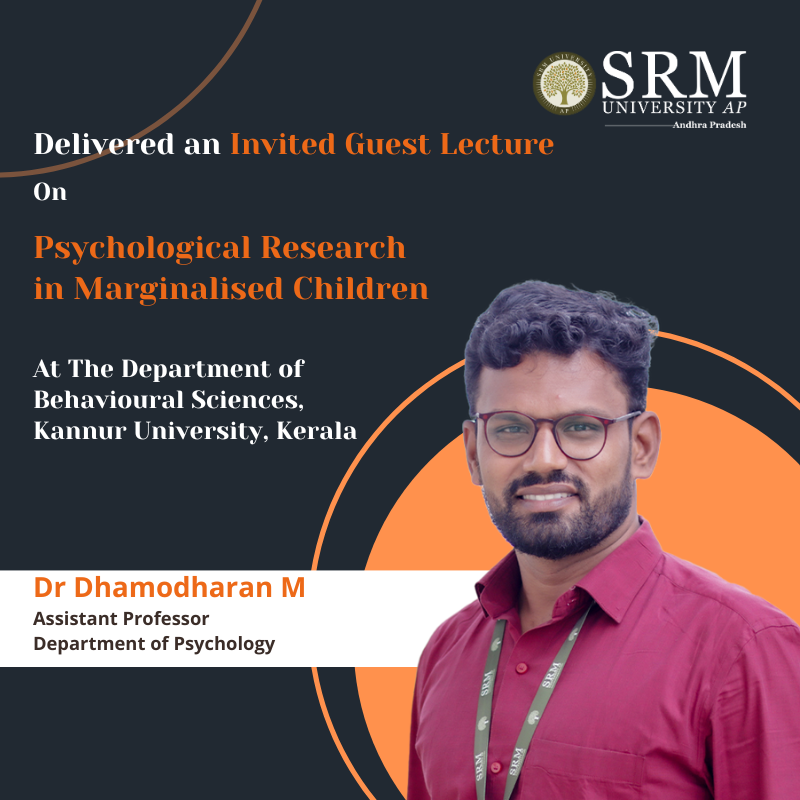
In an insightful talk at the Department of Behavioural Sciences in Kannur University, Dr Dhamodharan M, Assistant Professor at the Department of Psychology, SRM University-AP, shed light on “Psychological Research in Marginalized Children.” Dr Dhamodharan’s talk serves as a call to action, encouraging a deeper exploration of psychological research for the betterment of future generations.
Here’s an abstract of Dr Dhamodharan’s riveting talk.
Abstract
The invited lecture mainly focuses on the status and importance of psychological research in marginalized children. Marginalized People who are excluded from majority social, economic, educational, and/or cultural life. They are excluded due to race, gender identity, sexual orientation, age, physical ability, language, and/or immigration status (Baah et al.,2019). The term marginalized children include Children affected by or emerging from armed conflict or humanitarian crises, Children with disabilities, Children in remote or rural areas (including those who lack access to safe water and sanitation), Religious or ethnic minorities, Orphans, and children affected by HIV/AIDS, Child laborers, Married Children, Victims of trafficking (Legal Information Institute,2023). The World Health Organization defined “Child maltreatment is the abuse and neglect that occurs to children under 18 years of age. It includes all types of physical and emotional ill-treatment, sexual abuse, neglect, negligence, and commercial or other exploitation, which results in actual or potential harm to the child’s health, survival, development, or dignity in the context of a relationship of responsibility, trust or power” (World Health Organization, 2020). Children need essential nutrition, parental care, education, safety, entertainment, medical assistance, and physical, psychological, and social development (Deb & Ray, 2015). Children have their first human contact at home in a pleasant, nurturing, and caring environment; unfortunately, home is also where children are exposed to violence for the first time (United Nations Children’s Fund,2017). All children have the right to be safe from violence, oppression, and abuse. Despite this, globally, millions of children from all socioeconomic backgrounds, religions, cultures, and ages are subjected to violence and abuse daily. Violence against children is typical and endemic, and it is a terrible reality for millions of Indian children.
Over half of the world’s children have been subjected to extreme violence, with South Asia representing 64% of these instances (End Violence against Children | UNICEF India, n.d.) All types of violence against persons under 18 are considered violence against children. In 2019, about 1 billion children under eighteen experienced physical, sexual, or emotional violence or neglect globally (WHO, 2020). In the world, 3 out of 4 children aged 2-4 years were subjected to violent regulation from caregivers daily. Six out of ten children were exposed to physical punishment, one out of every two children aged 2 to 17 experienced some type of violence, and 18% of girl children experienced childhood sexual violence, while 8% of boys experienced the same (UNICEF, 2020; United Nations Children’s Fund, 2017). Victims of child abuse have also been exposed to more than one type of violence (Descartes et al., 2020).
Many countries are not prohibited corporal punishment. One in every two children aged 6 to 17 is subjected to corporal punishment. Around fifteen million girls aged 15 to 19 have been subjected to forced sex from partners, boyfriends, or husbands, with just one percent seeking professional help. Throughout the world, 1 in every three children aged 13 to 15 has experienced bullying at school. Girls face more psychological bullying than boys, whereas boys face more physical bullying than girls (UNICEF, 2020. Sexual assault and exploitation are the most common violence in slum regions. Those in positions of supremacy and authority, such as educators and leaders, are the primary perpetrators. Early pregnancy is also a serious concern among the underprivileged community, which leads to sexual exploitation (Nagasurendran, 2017).
Approximately 70 lakh children in India are not receiving all vaccinations, particularly in slum areas, migrant settlement areas such as fisher villages, construction sites, and inaccessible villages. This data is very high compared to all other countries globally. Proper childhood nutrition is a significant indicator of development and welfare, especially in developing countries. However, previous literature studies failed to focus on the children from the marginalized communities. The students from Psychology background need to explore the marginalized children’s health, education, and mental health. Furthermore, the marginalized children study findings would be an eye-opener for the social welfare department to take need-based welfare measures for marginalized children.
Current Status of Research
- Convenience sampling procedures overrepresent dominant groups (Rad et al., 2018)
- Only 5% of articles in one premier psychology journal predominately sampled ethnic minorities (Thalmayer et al., 2020)
- Less than 2% of psychological studies across three decades of research included sexual minorities as participants (Lee & Crawford, 2021)
Major Challenges faced by Marginalisation Children
- Health Issues – Malnutrition, Lack of healthcare facilities
- Lack of Educational Support
- Abuse and Violence
- Lack of Social Support
- Caste Discrimination
Areas to Study in Marginalization Children
- Discrimination in School and Community (Deb, 2019)
- Resilience and coping mechanisms (Dar,2020)
- Educational motivation and Teacher-student relationships (Martin,2020)
- Traumatic and Post Traumatic Stress (Szota,2023)
- Identity Formation (Yosef,2023)
- Social Support and Media Influence (Kaskazi,2023)
- Published in Departmental News, News, Psychology News
Physics Duo Publish in Prestigious Journal
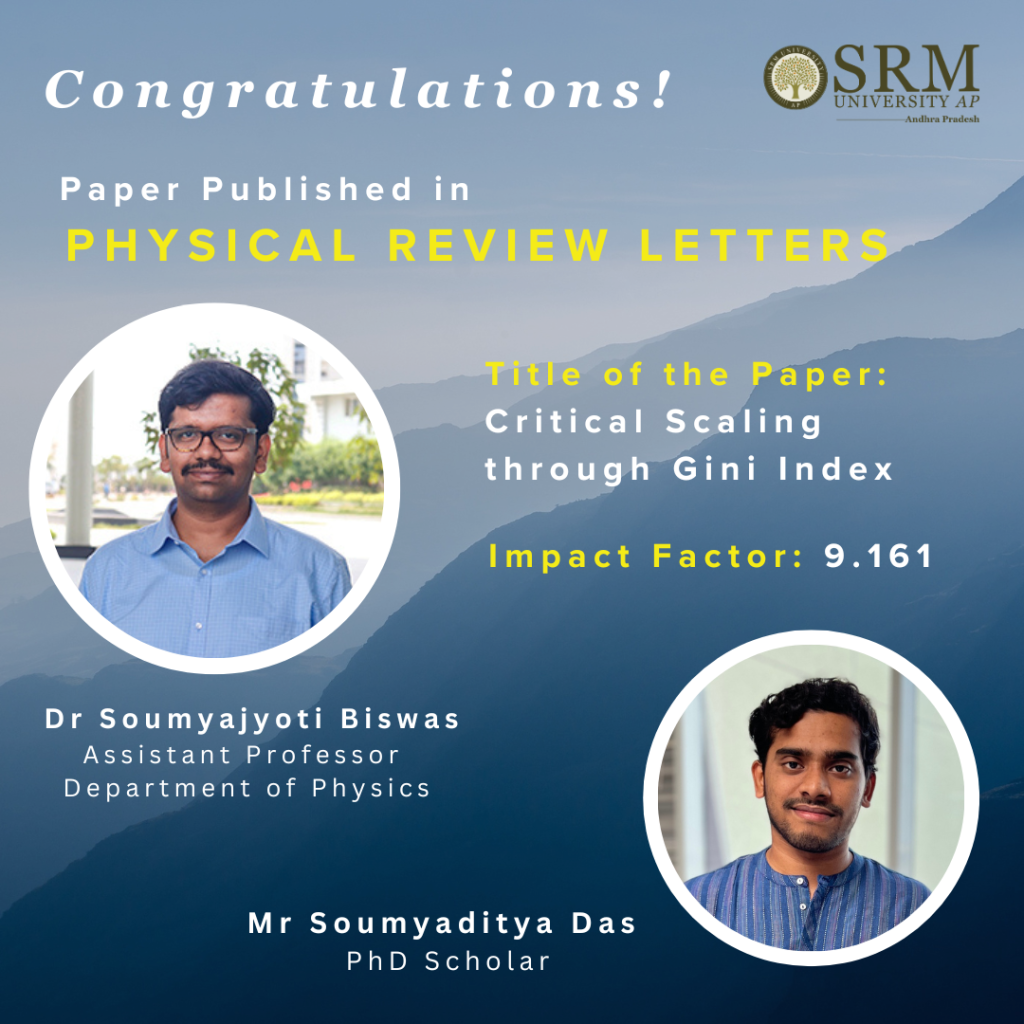
Dr Soumyajyoti Biswas, Assistant Professor in the Department of Physics, along with his Doctoral Scholar, Mr Soumyaditya Das, have presented groundbreaking findings through their research work titled “Critical Scaling through Gini Index”. The research paper was featured in the prestigious Physical Review Letters, which has an impact factor of 9.161.
Abstract
In the systems showing critical behaviour, various response functions have a singularity at the critical point. Therefore, as the driving field is tuned toward its critical value, the response functions change drastically, typically diverging with universal critical exponents. In this Letter, we quantify the inequality of response functions with measures traditionally used in economics, namely by constructing a Lorenz curve and calculating the corresponding Gini index. The scaling of such a response function, when written in terms of the Gini index, shows singularity at a point that is at least as universal as the corresponding critical exponent. The critical scaling, therefore, becomes a single parameter fit, which is a considerable simplification from the usual form where the critical point and critical exponents are independent. We also show that another measure of inequality, the Kolkata index, crosses the Gini index at a point just prior to the critical point. Therefore, monitoring these two inequality indices for a system where the critical point is not known can produce a precursory signal for imminent criticality. This could be useful in many systems, including condensed matter, bio- and geophysics to atmospheric physics. The generality and numerical validity of the calculations are shown with the Monte Carlo simulations of the two-dimensional Ising model, site percolation on the square lattice, and the fibre bundle model of fracture.

Fig.1: Shows the crossing point of the Gini index and the Kolkata index prior to critical point for three different models (from left Ising model in 2d, site percolation in 2d and fiber bundle model of fracture) form both side of critical point.
Collaborations and Future Plans
This work essentially builds a framework for indicating imminent critical points for any system. Therefore, in situations where such knowledge is vital, for example, in the fracture of solids, the method is going to be highly useful in forecasting the failure point. We are in the process of working with our collaborators at the University of Barcelona to experimentally verifying our methods for the compressive failure of porous samples. This is a significant first step towards opening new pathways in forecasting fracture points in disordered materials that could have an impact on laboratory-scale fractures to large constructions and eventually to earthquakes.
We wish the teacher-student duo many more fulfilling and enriching research endeavours in future!
- Published in Departmental News, News, Physics News, Research News
SRM AP Hosts Australian Delegation for Collaborative Initiatives
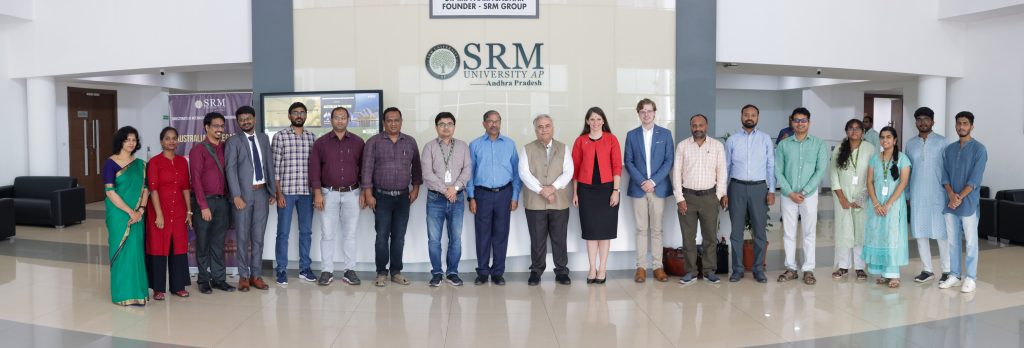
SRM University-AP played host to a dynamic and visionary Indo-Australian Collaboration Meet aimed at fostering academic partnerships and research collaborations between the two nations. The event featured a delegation led by H.E. Sarah Kirle, the Australian Consulate General. It occurred in the esteemed presence of Vice Chancellor Prof. Manoj K Arora and Registrar Dr R. Premkumar.
The Collaboration provided a platform for fruitful discussions and exploring potential collaborative initiatives between educational institutions in India and Australia. The discussions centred around ways to promote the exchange of knowledge, faculty and students, as well as joint research initiatives and cultural programs. Both parties expressed their commitment to developing academic exchange programmes that would allow students and faculty to gain a deeper understanding of each other’s cultures and educational environments. The meeting identified potential research areas where Australian institutions and SRM University-AP could work together to address global challenges and significantly contribute to the respective fields.
The panel featured discussions and brainstorming sessions, with research taking centre stage. The parties deliberated on developing a framework for collaborative research projects, which would encourage knowledge exchange and innovative solutions to global challenges. Discussions revolved around student and faculty exchange programmes, fellowship, and scholarship opportunities that would promote cross-cultural understanding and enrich the educational experience.
The visit served as a significant step in fostering relationships between SRM University-AP and Australian institutions, with the shared goal of promoting global education and research. It will signify a commitment to expanding horizons and offering students a broader and more enriching educational experience.
Empowering the Future of Education: SRMAP at Educators’ Meet
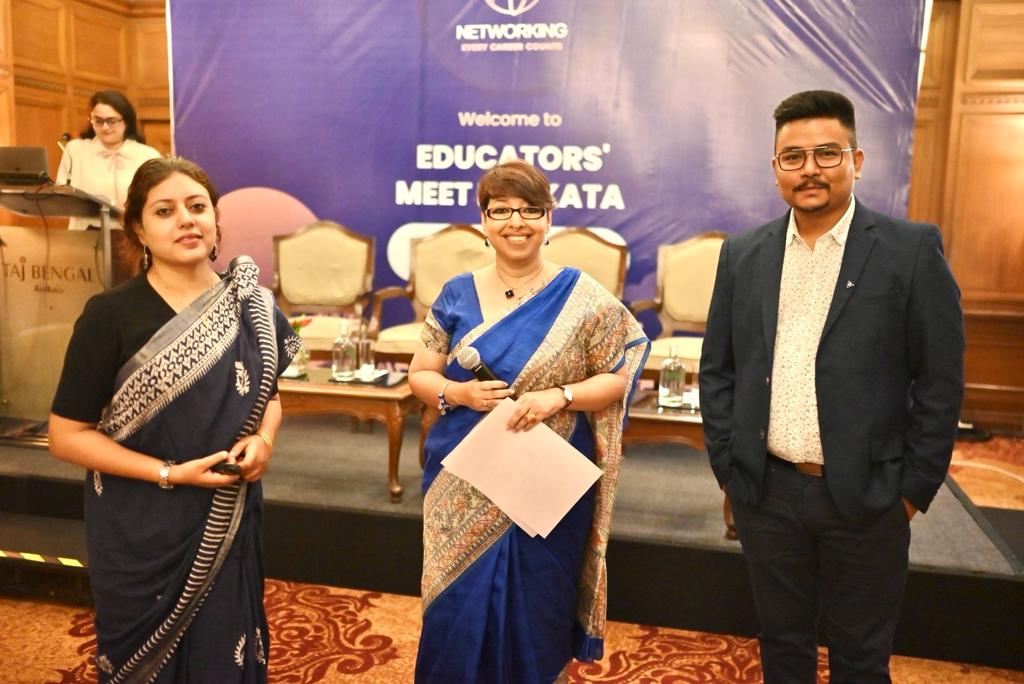
A transformative event in the field of education unfolded at the prestigious Taj Bengal Kolkata on September 30, 2023, as Networking, the event organiser, brought together visionaries, educators, and leaders from renowned institutions for a day of enlightening discussions. The symposium featured an engaging workshop on “Innovative Teaching Methods” and a panel discussion by acclaimed scholars from SRM University-AP and others on “Addressing Inclusivity in Education”.
SRM University-AP shared the stage with Mahindra University Hyderabad as presenters, sharing their insights into the dynamic world of academia. Their presentations provided a roadmap for educators to navigate the evolving landscape of teaching and learning. The event welcomed an illustrious audience, including the principals of some of Kolkata’s most esteemed schools, such as Don Bosco School, National English School, M P Birla Foundation Higher Secondary School, Ashok Hall Girls’ School, Sushila Birla Girls’ School, and Indus Valley World School and many more. This convergence of educational leaders was a testament to the growing need for innovation and inclusivity in the modern education system.
The workshop on Innovative Teaching Methods, led by SRM University-AP, aimed to empower educators with cutting-edge pedagogical tools and approaches. Presenters emphasised the need for adaptive learning, technology integration, and the nurturing of critical thinking skills. Attendees gained practical insights on how to create engaging, student-centered classrooms that inspire curiosity and creativity. The panel discussion on “Addressing Inclusivity in Education” was a powerful forum for introspection and collaboration. Renowned educator Dr Srabani Basu from SRM University-AP led the discourse on fostering an inclusive learning environment. The discussion revolved around strategies for accommodating diverse learning styles, ensuring equitable opportunities for all, and the role of education in shaping empathetic, well-rounded individuals.
A grand canvas was painted with discussions on “Preparing Students for Future Careers.” This event was more than just a meeting; it was a symphony of ideas, a platform for forging meaningful connections, and a springboard to a future of innovation and progress in education. The collaborative energy and innovative spirit that permeated the event offered a glimpse into the future of education. Participants left with a deeper understanding of the transformative power of innovative teaching methods and a collective commitment to make education accessible and inclusive for all. At SRM University-AP, we believe that events like these are pivotal in shaping the future of education. We are committed to embracing innovative teaching methods and fostering inclusivity to prepare our students for the dynamic and ever-evolving careers of the future.
- Published in Departmental Events, English, Events, History Events
Best Paper Award: Accorded to Dr Supen Kumar at MRAE 2023
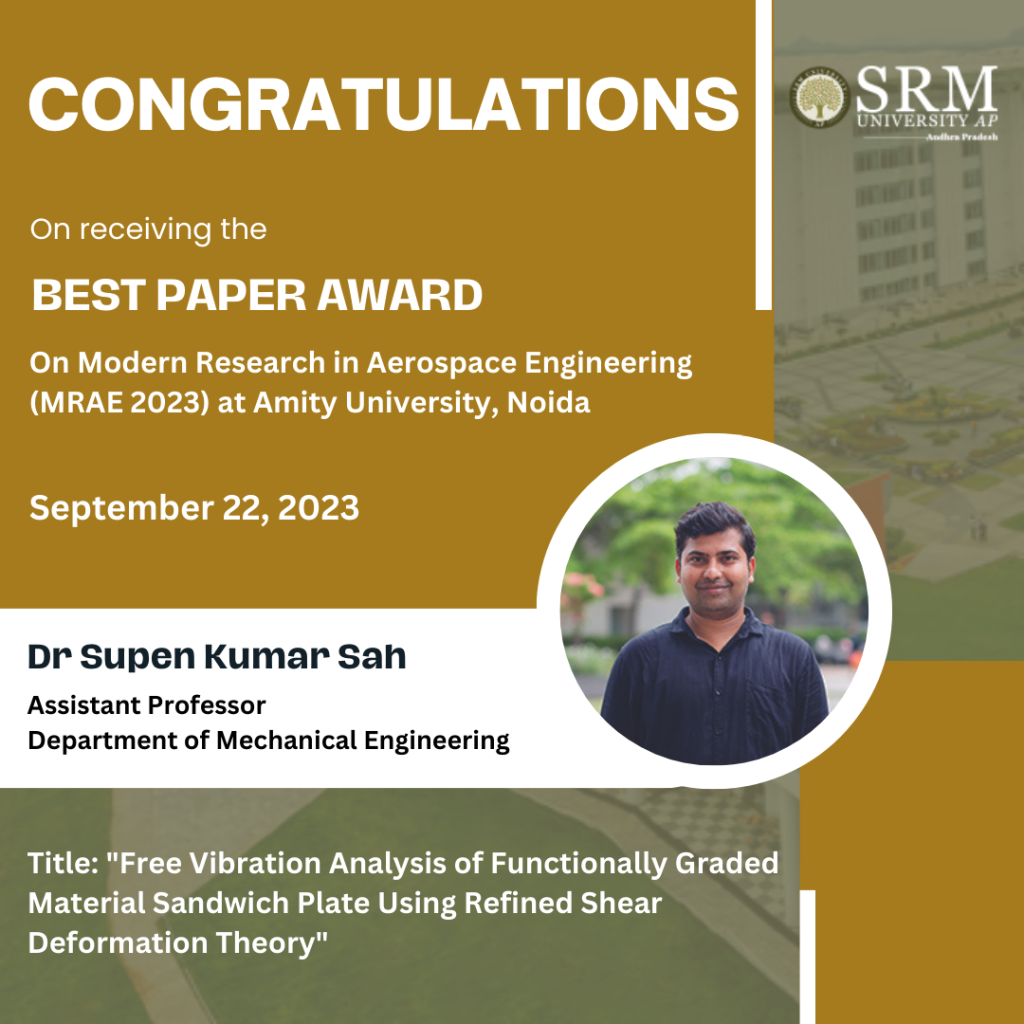
The Department of Mechanical Engineering is delighted to share that Dr Supen Kumar Sah, Assistant Professor, Department of Mechanical Engineering, has received the best paper award for his paper titled “Free Vibration Analysis of Functionally Graded Material Sandwich Plate Using Refined Shear Deformation Theory” in the 2nd International Conference on Modern Research in Aerospace Engineering (MRAE 2023). Dr Supen collaborated with Saloni Malviya of VIT, Bhopal, for the research paper. The paper explores the intricate dynamics of functionally graded material sandwich plates, employing a refined deformation theory. Dr Sah’s exceptional work has not only contributed to the scientific community but has also demonstrated his dedication and passion for advancing knowledge in the field of materials science and engineering.
Abstract
In the present study, free vibration analysis of a functionally graded material sandwich plate has been carried out using refined shear deformation theory. The shear correction factor is not needed since the parabolic variation of shear strain through the thickness is in such a way that shear stresses vanish on the plate surfaces. Hamilton’s principle is used for the derivation of the equation of motion for the theory. Additionally, Navier’s solution is used to obtain the eigenvalue equation for the sandwich plate. The three variants of sandwich plate are chosen for the analysis. To carry out the free vibration analysis three different types of FGM sandwich plate models namely 1-1-1, 1-2-1, and 2-2-1 have been considered. A power law defines the volume fraction index and the material properties of the individual layers of the sandwich plate. Lastly, the impact of parameters such as volume fraction, aspect ratio, and length-to-width ratio on frequency parameters is investigated.
Future Research Plans
• Modelling and Analysis of porous uni and multi-directional Functionally Graded Material (FGM) plates to obtain the impact of porosity distributions over structural responses.
• Analytical and finite Element Solutions for static and dynamic response of FGM sandwich plates employing non-polynomial shear deformation theories under elastic foundation.


- Published in Departmental News, Faculty Achievements, Mechanical Engineering NEWS, News, Research News


